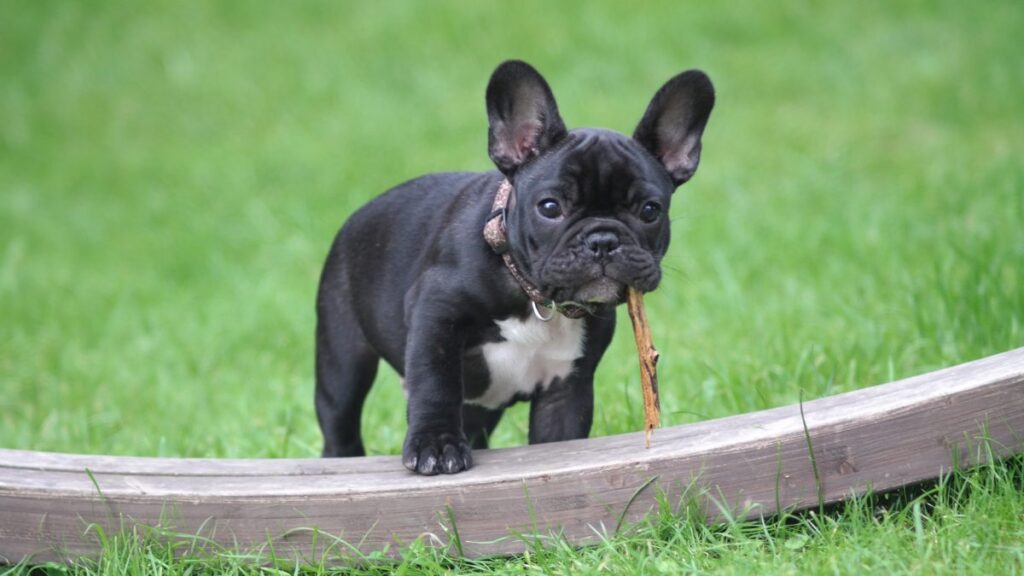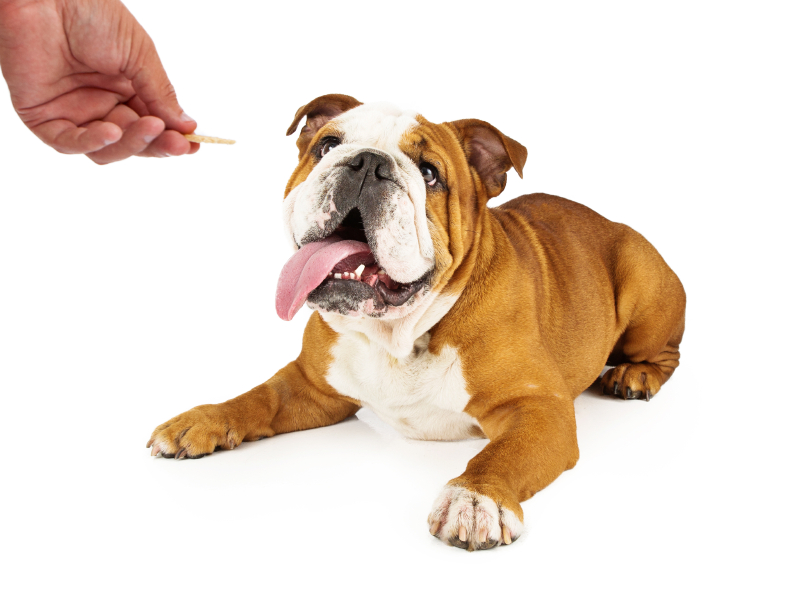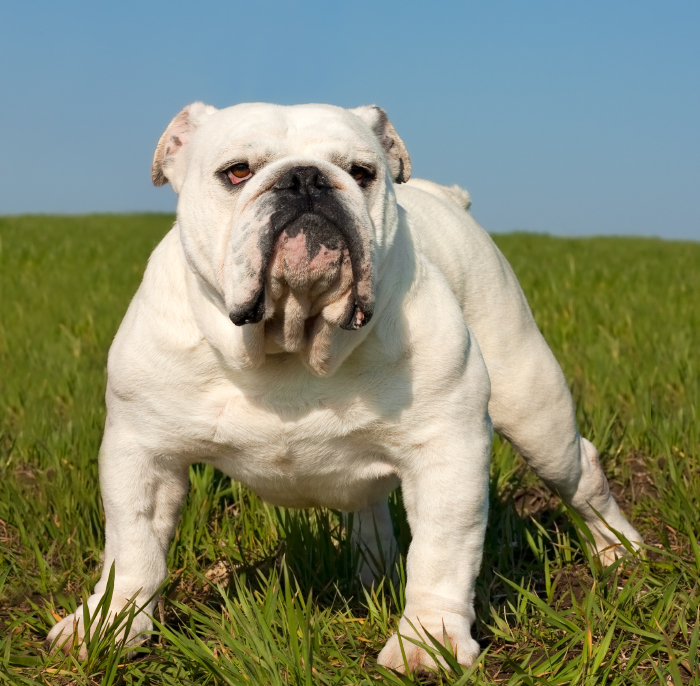Have you ever wondered about the different bulldog types and where the originated from? Historically, “bulldog” refers to any dog that was used in the sport of bull-baiting. This sport involved using dogs to pin down bulls by biting strongly on a bull’s snout. A bloody and dangerous sport with roots in England and Ireland in the 18th century. This would eventually be outlawed under animal cruelty laws. The Olde English Bulldogge was bred specifically for the sport. The bulldogs we see today descend from these early bull-baiting dogs. In this article, you’ll find all you need to know about the major types of bulldogs found today and I will introduce you to some rare bulldogs that breeders are trying to bring back!
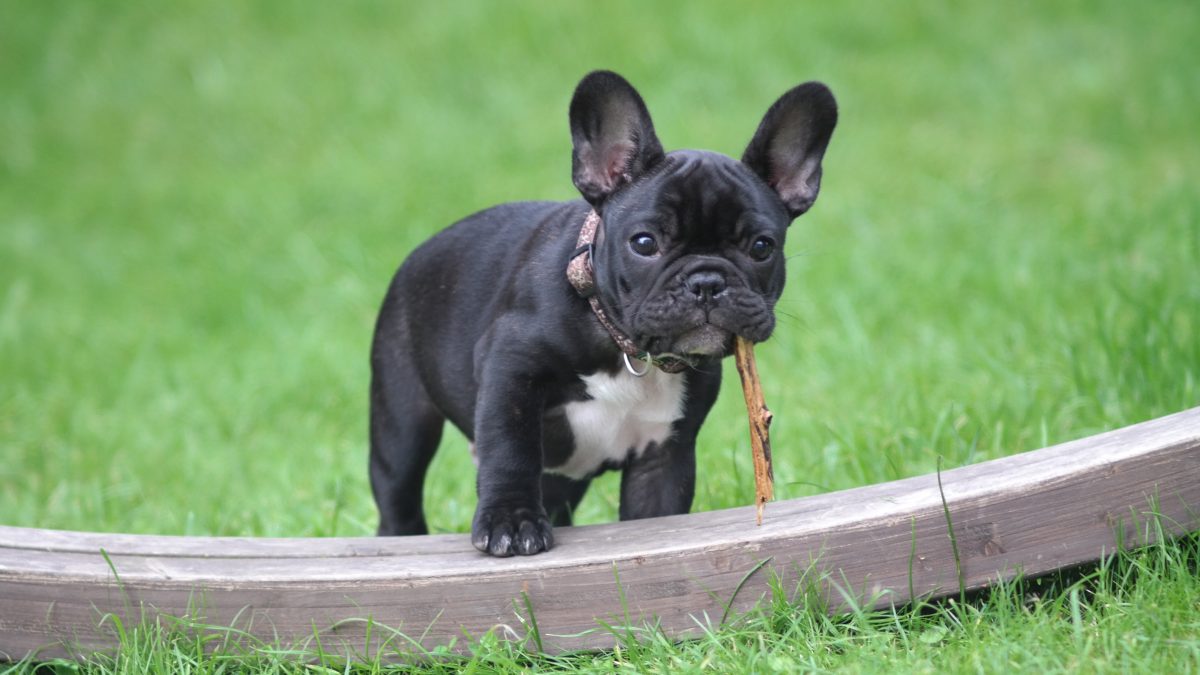
The most common and popular types of bulldogs include:
- English Bulldog
- French Bulldog
- American Bulldog
Rare bulldog breeds covered in this article:
- Olde English Bulldog
- Ca de Bou
- Alapaha Blue Blood
- Australian Bulldog
If you’re looking for a bulldog, there are plenty of different types! Below you’ll find out more about each breed and if they’ll make a great fit for your home!
Popular Bulldog Types
These breeds are the most common and most popular in the world.
English Bulldog
When using the term bulldog to describe an animal, we are generally referring to an English Bulldog. They are the original bulldog, being bred for their very unique physical characteristics. Known for their lovable disposition and laid-back nature, English Bulldogs have become the 5th most popular dog breed for pets.
Quick Stats:
Height: 14-15 inches
Weight: 40-50 lbs.
Lifespan: 10-12 years
Colors: Brindle, red, fawn, fallow, white and pied
Personality and Temperament
While their strength and sturdiness may come across as mean, English Bulldogs are known for being very friendly, gentle, and confident. They are love and attention-seeking from both owners and strangers, making them well-tempered and good with children. Most bulldogs are friendly around other dogs as well, but females can often be more aggressive with each other.
English Bulldogs have a tendency to be territorial over their food, so make sure you keep dogs separated during feeding time.
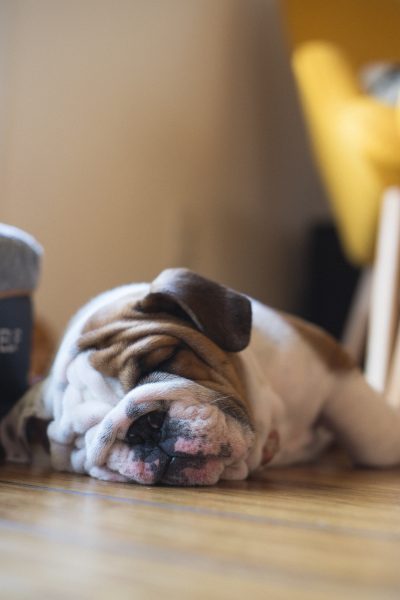
Health Concerns
The most important thing you need to know about English Bulldogs is that they are prone to a high amount of health concerns and illnesses. To achieve their desired physical characteristics, many health problems developed over time.
- Brachycephalic Syndrome: With short noses and heads, bulldogs’ nasal passages and trachea are smaller. This along with an elongated soft palate makes it more difficult to breathe and could lead to more serious health problems later in life.
- Infection: Bulldogs have lots of crevices for infections to grow. They are most prone to infection in their eyes, ears, face folds, skin, and between their toes. Food allergies can also be the cause of many skin irritations. Consistent bathing and medication can control infection.
- Hip and Joint Pain: English Bulldogs (most bulldog breeds as well) can suffer from hip dysplasia, causing pain in surrounding joints. Their skeletal makeup makes them more likely to develop deformities and chronic pain.
- Heart Conditions: Heart diseases are common in English Bulldogs, especially as they age. Bulldogs should have their hearts checked at vet visits to monitor activity.
- Entropion: This condition causes your eyelid to invert, allowing your eyelashes and skin rubs directly on the eye. This causes irritation, discomfort, and worsened vision.
These are some of the major health concerns that impact a significant portion of English Bulldogs. Medical bills are typically higher for English Bulldogs than other breeds due to these concerns. Routine check-ups generally cost more as well due to their unique characteristics.
Lifestyle Needs for This Bulldog Type
If you take away their medical needs, bulldogs are low maintenance pets. They do not require much exercise, around 20 minutes per day, and do not need a large yard at home. They are the perfect couch potato companion. For more active owners, English bulldogs do not do well on long runs or hikes.
Bulldogs are also very sensitive to heat. With great risk of overheating and heat stroke, it is best for them to live in temperate climates or be closely monitored in warm environments.
Grooming needs are very minimal with their short soft coats. They are average shedders and you should brush them around once a week to eliminate excess hair. Washing should be regular, around once every week or two. Wiping down facial folds regularly will help to prevent infections.
French Bulldog
Our favorite little bat-eared companions find their roots in England! They were bred by mixing English Bulldogs and terriers to create a smaller, toy-sized bulldog. Lace makers in Nottingham brought their little bulldogs to France as the industry moved.
French Bulldogs, or “Frenchies,” are massively popular all over the world. Known for their big ears and small, muscular bodies, Frenchies have many similar characteristics to their English counterparts but are typically more athletic.
Quick Stats:
Height: 10-12 inches
Weight: 20-24 lbs.
Lifespan: 10-12 years
Colors: Fawn, pied, brindle, white, cream, blue, black
Personality and Temperament
French Bulldogs have a funny face with a personality to match! Frenchies are clever, comical, and charming, making them good pets for families. They get along well with other people and dogs, constantly looking for attention from anyone that passes them.
The breed makes funny noises and overall have good temperament. They are not typically aggressive dogs but may have the tendency to be stubborn.
Health Concerns
French Bulldogs suffer from many of the same health issues that impact their English Bulldog ancestor. These are concerns that Frenchies are more susceptible to than other dog breeds:
- Brachycephalic Syndrome: Almost all bulldog breeds suffer from this condition, making it more difficult for the animals to breathe.
- Infection: Face folds are breeding grounds for infection as well as chronic allergies that may cause skin irritations.
- Spinal Malformations: Bred for their specific bodies, many French Bulldogs will have deformed bones and vertebrae. This leads to high rates of intervertebral disk disease and pain throughout their lives.
- Entropion: This eyelid deformation impacts multiple types of bulldogs and can cause great discomfort for your dog.
Lifestyle Needs for This Bulldog Type
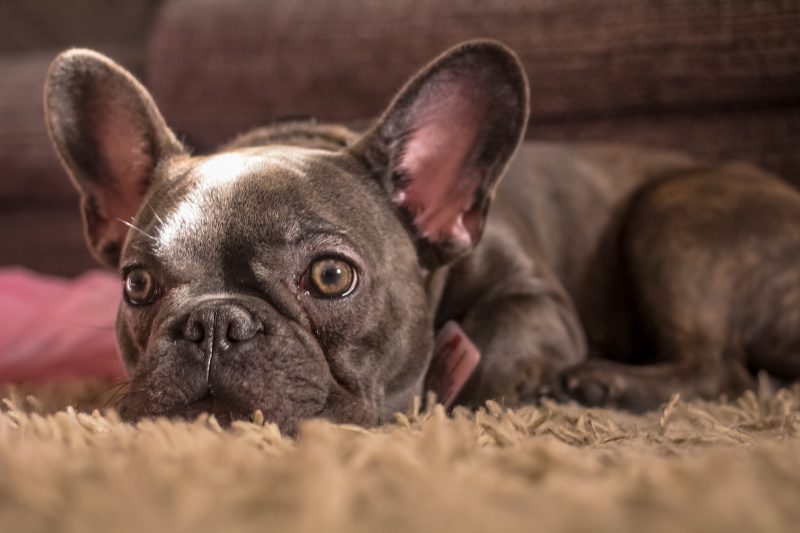
French Bulldogs make the perfect pet for any sized home. They are suitable for apartments or homes with yards and do not require significant exercise. They enjoy running, but typically in smaller segments. Look to exercise your Frenchie for about 30 minutes per day; they are good with short walks and runs. However, they are not the best companion if you like long hikes.
Living in temperate climates is important for this breed as they are at risk of overheating. Make sure you keep track of them when they are in extreme temperatures.
Grooming requires weekly brushing and somewhat regular bathing. Bathing every week or two is suitable to keep their coat fresh and prevent infections. Their short hair sheds less than most dog breeds, but you’ll still find little pieces on all your clothes!
American Bulldog
English Bulldogs were brought to the United States to be used as working dogs on farms. Their strength and determination in the bull baiting days made them attractive candidates for work. They were then bred with other working dogs to create a more athletic, yet similar tempered version of the original bulldog.
American Bulldogs are typically divided into Johnson and Scott variations. Johnson American Bulldogs were created by breeding English Bulldogs with work dogs while Scott American Bulldogs bred Johnson Bulldogs with other working dogs. The main difference between the two is in build and appearance. Johnsons resemble English Bulldogs more closely and Scott Bulldogs appear more like pit bulls. Overall, both versions are fairly similar in personality and needs.
Quick Stats:
Height: 22-27 inches
Weight: 70-120 lbs. (males), 60-100 lbs. (females)
Lifespan: 12-15 years
Color: White with brown, black, red patches; sometimes brown
Personality and Temperament
Much like the disposition of English Bulldogs, Americans are friendly, confident, great with kids, and reliable. With size to their advantage, they are strong protectors and loyal to their owners. Early socialization is key to ensure their friendliness with other dogs.
They do not typically bark unless they are presented with a threat. American Bulldogs can become aggressive toward things they deem dangerous or “prey,” such as small rodents and animals. This is why they should be kept on a leash on walks in case small dogs or cats become visible.
American Bulldogs are great family dogs that require a lot of attention, time, and love.
Health Concerns
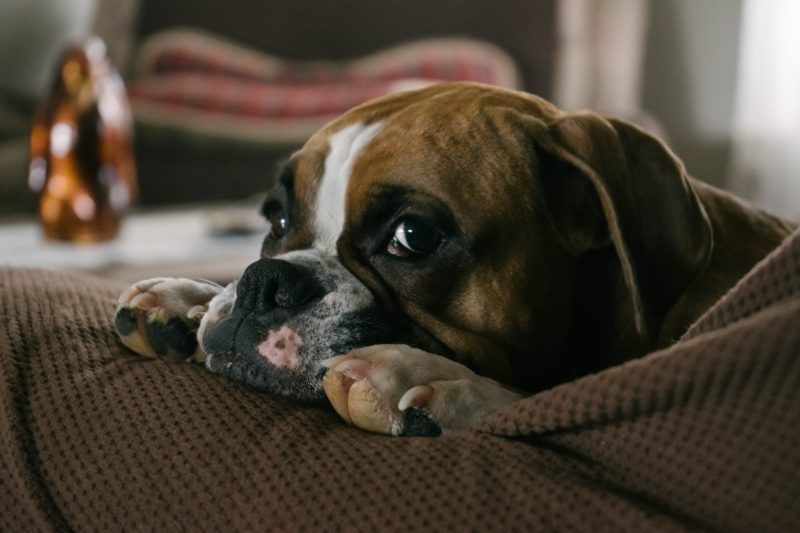
American Bulldogs are prone to some similar conditions as other bulldogs but have additional concerns you should be mindful of.
- Brachycephalic syndrome
- Entropion: American bulldogs are also more prone to cataracts in the eyes.
- Hip dysplasia: More common in larger animals, even more, likely in this bully breed.
- Dental disease: Make sure you clean their teeth regularly.
- Nerve disease: These diseases may cause leg weakness and issues with imbalance.
- Hypothyroidism
- Kidney and bladder stones
- Sunburn/skin cancer: White hair exposes them to these conditions more easily than other breeds.
Lifestyle Needs for This Bulldog Type
As they were bred for their working abilities, American Bulldogs have a lot of energy and are best suited for homes with larger yards.
American Bulldogs need much more exercise than other bulldogs. They will rip items in your house apart or get into trouble if they are left neglected or not exercised regularly. They are a great exercise partner, suitable for runs and hikes. This breed is intelligent as well, making them a great fit for exercises that require a mental component. Nose work, or activities simulating hunting through smell, will keep them actively challenged.
If you can accommodate more energy and can exercise them a lot, the Scott American Bulldog is a good option. For those who cannot exercise their dog as much or have a smaller yard, a Johnson may be a better choice.
Grooming is very similar to English and French Bulldogs with minimal shedding and easy wash and brushing needs.
Rare Bulldog Breeds
Breeders have made an effort to bring many extinct bulldog breeds back into popularity. This is done by combining different breeds to achieve the same characteristics these breeds once possessed.
Olde English Bulldogge
Before English Bulldogs were bred for their large heads and smaller bodies, the original or “Olde” English Bulldog was a more powerful, muscular, and larger version of the English Bulldog dating back to the 18th century. Weighing between 60-80 pounds, it was more athletic and used as a working dog.
With the same friendly and confident temperament as the modern bulldog, they were very desirable both as bull-baiting animals and pets.
Olde English Bulldogges were bred again in the 1970s to eliminate the health problems of the modern English Bulldog and restore the original working dog breed.
Ca de Bou
This breed of bulldog dates back as far as 1000 BCE, the Ancient Egyptians and the people Roman Empire would trade these dogs. With roots in Spain, it was originally a mix of English Bulldog and local dogs who were more heat tolerant.
With the typical mild bulldog temperament, they are loyal, friendly, and playful dogs. They do require significant exercise and you should only own one if you are able to satisfy these needs. They are good with children and early training should be encouraged for good habits.
Alapaha Blue Blood Bulldog
Descendants of Old Country bulldogs in the American South, they are incredibly rare. People began breeding them again in the 1970s and worldwide interest has grown since then. With fewer breathing issues than most bulldogs, this breed is athletic, agile, and makes a great guard dog.
They are good with children, not super friendly with strangers (both human and animal), and need firmness and consistency in discipline. Alapaha’s are very prey-driven, territorial, and need a yard with a fence.
These bulldogs require moderate exercise and will chew through things in your home if left alone! You can learn more about this bulldog type at The Alapaha Blue-Blood Bulldog Association.
Australian Bulldog
Bred specifically to handle the harsh Australian elements, they are much more muscular than those found in the United States. They are strong like terriers but have the temperament of the American Bulldog. These dogs are very loving and great companions.
Often used as guard dogs, they are strong protectors. They also require more exercise than typical bulldogs, enjoying long walks and being able to handle hot climates.
All bulldogs are known for their lovable nature and unique looks. Their loyalty, curiosity, and confidence make them a wonderful addition to a family home. Depending on your needs and abilities in care, there are a variety of bulldog options to suit your lifestyle!
You May Also Like:
13 Things to Know About English Bulldog Puppies
French Bulldog Clothes; 20 Great Outfits For Pups And Owners
Over 100 Amazing Bulldog Names + Tips on Choosing the Right Name!
